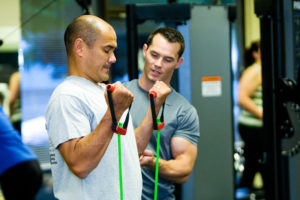16 Jun Posture and Avoiding Exercise Injuries
Proper posture is vital during exercise if you want to avoid injuries, especially while lifting weights. Many people know that you should lift with your legs instead of your back to avoiding injury. However, there are many other types of tips regarding posture, balance, and training that can help you avoid exercise injuries. Use these tips to stay strong and avoid injuries!
Injured Exercising?
Many people who exercise consistently have sustained an injury at some point, even if it’s a mild one. Exercise injuries can stem from weight-bearing exercises (lifting weights) and can come from overuse (even walking and running too much).
Sports can cause injuries fairly easily, as many sports are contact ones, and it’s impossible to always control the actions of others. However, you can control your environment and your own actions when it comes to avoiding injuries. Exercise injuries are ones that are the easiest to prevent if you know what you’re doing. Many people get injured because they simply didn’t know their actions could lead to injury. We love to help patients grow strong and recover from injuries, but we prefer that they didn’t happen in the first place, especially exercise injuries.
Posture and Exercising
23% of adults sustain exercise injuries, many of which stem from improper posture or technique or overuse. Many older adults fear exercising because they assume they will be injured, when in fact people can actually exercise until the day they die without incident. The key is exercising correctly to build strength, endurance, and better health while avoiding exercise injuries.
41% of injuries happen in the lower half of the body, most of which consist of muscle strains. Back injuries are also fairly common. Posture can make the difference between health and sickness, injury or strong muscles. When you exercise, your body should follow a straight line when walking, running, lifting weights and more. Your back should never be arched or your limbs or neck strained at odd angles. You should always lift with your legs instead of with your back. People who don’t do this often are the ones that end up with exercise injuries while lifting weights.
With almost every workout, your neck should be in a straight line with your back. Your chin should not be up towards the ceiling or down against your chest. This can pinch and compress nerves and stretch muscles in abnormal directions. It’s helpful for many patients to watch their exercises and lifts in a mirror as they do them so they can see that all of their limbs are aligned correctly and evenly.
Warm-Up and Exercise Aids
When exercising, always do a warm-up for 5-10 minutes to get your muscles moving and your blood pumping. Then, start into your actual workout. Don’t cold-stretch as this could cause exercise injuries. After a warm-up, do light stretching and then do regular stretching after your full workout is completed. You should structure your body in a position that makes exercising the smoothest and easiest on your body as you build strength. In preparation for a workout, make sure you have the right athletic gear on to fit your sport or exercise you are doing.
A properly-structured diet can also make the difference between a good workout and a bad one. If you don’t eat protein-packed foods and stay hydrated before, during and after a workout, you will get fatigued. When you’re tired, you don’t focus on posture and proper technique as much. Your brain can become clouded and you can get dizzy and faint. Proper fuel and hydration provides clarity of mind so that you can focus on proper posture and technique with every workout.
When stretching and cooling-down, you also want to make sure you are stretching correctly and not over-doing it. Just like with the actual workouts and exercises you are doing, get advice from a medical professional on how you should cool-down and stretch for optimal recovery and muscle-building.
Exercising Around Exercise Injuries
Just because you are injured, doesn’t mean that you have to stop exercising. You may simply have to go about it a different way. A physical or chiropractic therapist can assess your injury and provide you with specific exercise to build your injured muscles and tissues. Just as you build strength with specific techniques, posture and repetition, you will heal in the same way through chiropractic and physical rehabilitation therapies.
Vibration therapy also works wonders for patients who are trying to stay in shape, but have exercise injuries. This therapy consists of a machine that a patient stands on and is strapped to. In 7 minutes or less, the machine will send countless vibrations through the body that stimulates the muscles. Those muscles contract and relax dozens of times per second, leaving the muscles with a complete workout even though the patient was simply standing on the machine. This is great for keeping muscles healthy and moving during injury, the wintertime or in patients of very old age or who have chronic conditions.
Physical and Chiropractic Therapy for Wellness
With injuries, our advice is to definitely see a physical and chiropractic therapist for injury assessment and treatment. There is a reason medical doctors refer injured patients to these professionals. They provide a customized plan of very structured exercises with specific positions that build back muscles and tissues the quickest.
Patients that are injured or recovering from surgery can often make a quicker recovery if they do therapy as opposed to patients who don’t do anything. With exercising, always make sure you know and utilize proper posture and technique every single time. Never rush through an exercise or make yourself reach a goal you’re not ready for. When exercise injuries strike, call Mile High Spine & Pain Center at (720) 507-0080!





